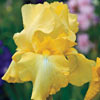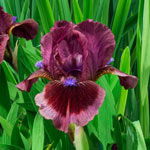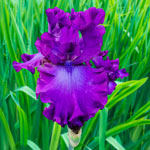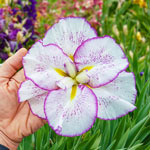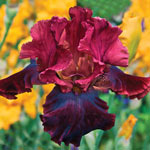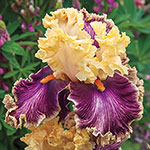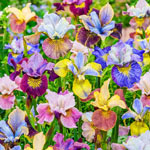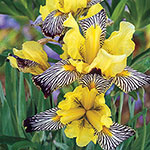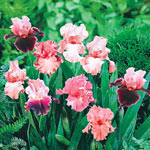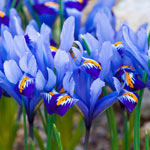Iris Bulbs & Rhizomes
A classic garden favorite, the beautiful iris flower is sure to spruce up your garden. With its unique colors and shapes, this sun perennial will offer an exotic flair to your landscapes. Explore our iris bulbs and rhizomes for sale today!
All About Iris Flowers
Iris is a genus of 260-300 species of flowering plants with showy flowers. The word 'Iris' is Greek for 'rainbow' and these showy plants justify their title by offering a rainbow of flower colors, including crisp whites, pastels, vibrant reds, indigo blues and even black! Our Iris flower selection includes the world-renowned Dutch Irises—hybrids resulted from crossing species native to North Africa and Spain. While hybrid Irises plants commonly produce yellow and white flowers, our breeders have come up with exotic new hues of purple, blue and red—surefire show stealers in every setting! We also carry top-tier bearded iris and Siberian iris varieties guaranteed to make the spring and summer the best ever for your garden!When Should You Plant Iris Bulbs and Rhizomes?
The best time to plant bearded iris is July through September. This allows enough time for the flowers to become established before winter.Where Do Iris Plants Grow Best?
Irises are hardy, easy to grow plants with attractive foliage and spectacular flowers—good for every garden design. Iris flowers need at least a half day of sun and thrive in most climates. In extremely hot climates, some shade is more beneficial, however, irises do better with at least 6 hours of full sun a day. Bearded Iris should be planted so the tops of the rhizomes are exposed and the roots are spread out facing downward in the soil.Plant your Dutch Iris (Iris hollandica) bulbs 3-4" deep and 3-4" apart in light, fertile, well-drained soil. Dutch Iris prefer bright, sunny locations but can live in partial shade. If you have clay-heavy soil, add some coarse sand and humus. Irises enjoy a low-nitrogen fertilizer.
Japanese Iris prefer bright, sunny locations but can live in partial shade. They require high soil moisture and a fair amount of feeding throughout their growth period. Space plants 2 feet or more apart in heavy soil, amended with compost and peat. No lime! Wait until you see new growth before fertilizing, then feed again just before bloom. Japanese Iris are also a favorite water plant grown in containers in pond shallows.
How Do You Plant Iris Bulbs and Rhizomes?
Set the bulb firmly to hold the plant in place near the surface. Firm the soil tightly and allow enough for settling to keep the bulbs above any possible standing water. The top of the bulb should be just beneath the surface of the soil. If you have several plants, plant them at least a foot and a half apart, "facing" the same way.For bearded irises, dig a shallow hole large enough for the rhizome clump in a well-cultivated bed. Create a mound of soil in the center of the hole. Make sure the mound is high enough to allow the top of the rhizome to poke out slightly above the soil level. Spread the roots around the mound, fill it with soil and water. For a colorful group planting, plant at least three rhizomes (about 8-10" apart) or plant undivided clumps. Be sure to point each fan of leaves away from the center of the group. Before flowering, water plants often enough to keep the soil moist but not soaked. Apply mulch to fall-planted irises to reduce winter heaving.
How Do I Spread Out Iris Flowers?
Over time iris clumps become crowded and the blooms may suffer. But it is easy to spread out your irises and encourage new growth. In late summer, carefully lift the entire clump with a garden fork. Cut apart the new, younger sections from the original center rhizome, then replant. You may want to let the rhizomes dry in the sun for a day before replanting. Unless you see new buds coming off the center rhizome, discard it—it is past its prime and unlikely to bloom a second time. The "babies" are what you want to save.When Should Iris Plants Be Cut Back?
By early fall, iris leaves are usually ready to be cut back to about 6 to 8 inches above the ground. Then, wait until after the first hard frost.How Do I Take Care of Iris Bulbs and Rhizomes?
No matter the variety you choose to grow, there are a few things you can do to help your irises thrive in your garden. Follow these tips below for the healthiest blooms.Plant irises in a sunny spot in late summer. The plants need well-drained soil and at least six hours of sunlight per day. A full day of sun is even better to keep the rhizomes dry.
Prepare iris beds. Use a low-nitrogen fertilizer and apply it twice a year: In early spring and just after bloom when the rhizomes are forming the next year's flowers. Only water if it's extremely dry or after transplanting.
Give them room to breathe. Bearded irises need good air circulation. Plant them a minimum of 16 to 18 inches apart (less space for dwarf irises and more for tall bearded iris varieties).
Do not mulch. Mulching helps the soil retain moisture, and too much moisture will cause the rhizomes to rot.
Remove seedpods that form after the blooms have faded. This prevents seedlings from choking the surrounding soil. Seed formation also saps energy needed by the rhizomes, roots, and leaves.
Prune back the foliage in the fall. This will reduce the chances of overwintering pests and diseases. Make dividing a habit. Divide clumps of bearded iris plants every three to four years in late summer.
Fertilizing Irises
Although bearded iris don't need a lot, a small serving of specially-designed iris fertilizer can make your display grow even stronger and healthier. Breck's® Iris Lovers All-Natural Iris Food uses a 4-4-2 ratio of nitrogen, phosphorus and potassium, respectively. Our iris food is well-balanced, so your irises won't be over- or underfed. Nitrogen is vital for healthy growing, but too much can cause soft, disease-prone growth. A small dose of phosphorus is useful when producing flowers and developing roots, and some potassium helps bring out those rich, vibrant colours that make iris so lovely. Our iris fertilizer has less phosphorus and potassium than our other fertilizers, and just enough of all three key nutrients to give your bearded beauties the boost they deserve!What Does an Iris Flower Symbolize?
The term "iris" comes from the Greek word for rainbow. In Greek mythology, Iris is a messenger of the gods, a link between the heavens and the earth. Iris, and the flower named for her, are associated with rainbows.In Christian Easter celebrations, irises are common due to their springtime blooming. They also represent the Trinity, thanks to their three distinct petals. You'll often find irises in Easter arrangements, baskets, and used to decorate churches during Eastertide.
The Victorian era language of flowers also assigns a host of meanings to iris flowers. They can represent faith, hope, and courage. Because of their roots in Greek mythology, they also represent the delivery of a special message.






